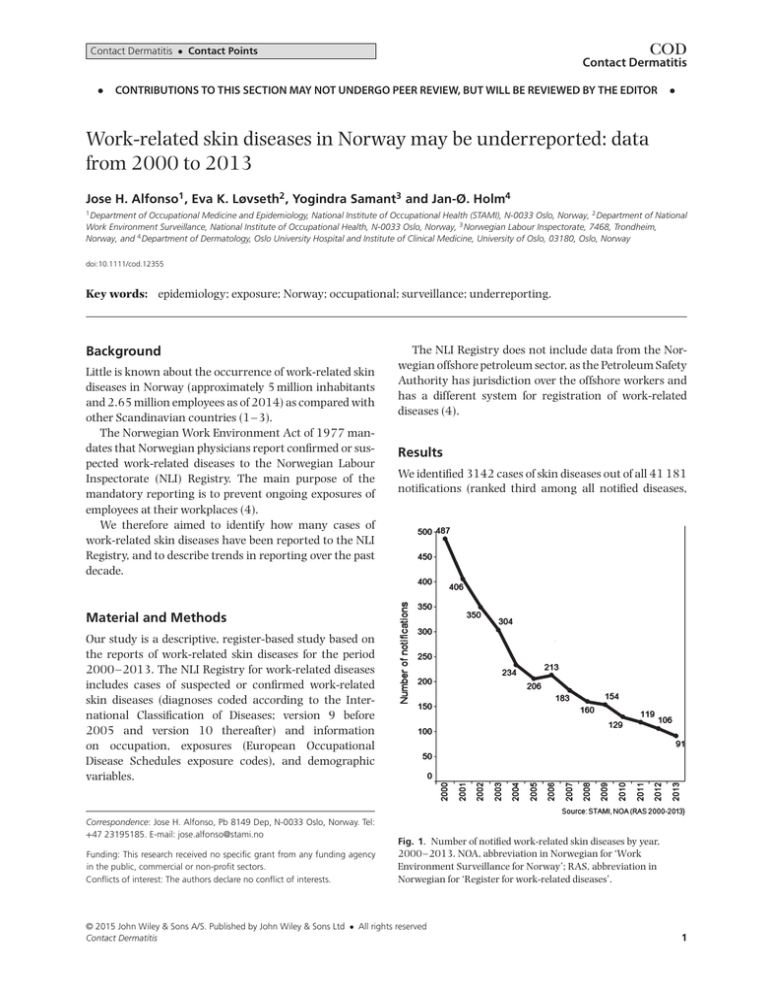
COD
Contact Dermatitis • Contact Points
Contact Dermatitis
• CONTRIBUTIONS TO THIS SECTION MAY NOT UNDERGO PEER REVIEW, BUT WILL BE REVIEWED BY THE EDITOR •
Work-related skin diseases in Norway may be underreported: data
from 2000 to 2013
Jose H. Alfonso1 , Eva K. Løvseth2 , Yogindra Samant3 and Jan-Ø. Holm4
1 Department
of Occupational Medicine and Epidemiology, National Institute of Occupational Health (STAMI), N-0033 Oslo, Norway, 2 Department of National
Work Environment Surveillance, National Institute of Occupational Health, N-0033 Oslo, Norway, 3 Norwegian Labour Inspectorate, 7468, Trondheim,
Norway, and 4 Department of Dermatology, Oslo University Hospital and Institute of Clinical Medicine, University of Oslo, 03180, Oslo, Norway
doi:10.1111/cod.12355
Key words: epidemiology; exposure; Norway; occupational; surveillance; underreporting.
Background
Little is known about the occurrence of work-related skin
diseases in Norway (approximately 5 million inhabitants
and 2.65 million employees as of 2014) as compared with
other Scandinavian countries (1–3).
The Norwegian Work Environment Act of 1977 mandates that Norwegian physicians report confirmed or suspected work-related diseases to the Norwegian Labour
Inspectorate (NLI) Registry. The main purpose of the
mandatory reporting is to prevent ongoing exposures of
employees at their workplaces (4).
We therefore aimed to identify how many cases of
work-related skin diseases have been reported to the NLI
Registry, and to describe trends in reporting over the past
decade.
The NLI Registry does not include data from the Norwegian offshore petroleum sector, as the Petroleum Safety
Authority has jurisdiction over the offshore workers and
has a different system for registration of work-related
diseases (4).
Results
We identified 3142 cases of skin diseases out of all 41 181
notifications (ranked third among all notified diseases,
Material and Methods
Our study is a descriptive, register-based study based on
the reports of work-related skin diseases for the period
2000–2013. The NLI Registry for work-related diseases
includes cases of suspected or confirmed work-related
skin diseases (diagnoses coded according to the International Classification of Diseases; version 9 before
2005 and version 10 thereafter) and information
on occupation, exposures (European Occupational
Disease Schedules exposure codes), and demographic
variables.
Correspondence: Jose H. Alfonso, Pb 8149 Dep, N-0033 Oslo, Norway. Tel:
+47 23195185. E-mail: jose.alfonso@stami.no
Funding: This research received no specific grant from any funding agency
in the public, commercial or non-profit sectors.
Conflicts of interest: The authors declare no conflict of interests.
Fig. 1. Number of notified work-related skin diseases by year,
2000–2013. NOA, abbreviation in Norwegian for ‘Work
Environment Surveillance for Norway’; RAS, abbreviation in
Norwegian for ‘Register for work-related diseases’.
© 2015 John Wiley & Sons A/S. Published by John Wiley & Sons Ltd • All rights reserved
Contact Dermatitis
1
Contact Dermatitis • Contact Points
WORK-RELATED SKIN DISEASES IN NORWAY MAY BE UNDERREPORTED • ALFONSO ET AL.
Female
Male
Fig. 2. Occupations by sex for notified work-related skin diseases 2000–2013. NOA, abbreviation in Norwegian for ‘Work Environment
Surveillance for Norway’; RAS, abbreviation in Norwegian for ‘Register for work-related diseases’.
after diseases of the ear and the respiratory system). The
total number of notified skin diseases declined over this
period (Fig. 1).
Contact dermatitis (CD) accounted for 94% of all cases
(41% allergic CD, 43% irritant CD, and 10% unspecified
CD). The most common occupations are shown in Fig. 2.
The commonest exposures are shown in Fig. 3.
Discussion
The substantial decline in the total number of annual
notifications, including work-related skin diseases, over
the past decade is noteworthy. For the period from
2002 to 2010, 286 cases of occupational skin diseases
were reported to the Association of Norwegian Private
Insurance Companies registry of occupational injuries,
representing ∼15% of the skin conditions reported to the
NLI for the same period of time (5).
A simplified reporting system, with regular follow-up,
was tried out during a 2-year-period (1994–1995) in
Oslo; only 24% of the work-related skin diseases reported
here were also reported to the NLI registry (6).
2
It seems plausible that the decline in the number
of notifications might be attributable to considerable
underreporting. Underreporting of work-related conditions is a universal phenomenon that undermines the
findings of register-based studies (7). In a survey covering
14 European countries (not including Norway), only
Finland and Luxembourg replied that underreporting of
occupational diseases was not considered to be a cause
for concern in their countries (8). As suggested earlier,
underreporting in the general population may be partly
influenced by barriers to reporting that are present at
each stage, from the diagnosis and management of these
diseases until the official reporting registries (9). Other
reasons may include employees’ beliefs that their health
problems are ordinary consequences of their job, or that
their symptoms are not serious enough (10), physicians
failing to diagnose or assess the work-relatedness of
health problems, lack of reporting prioritizing because of
high total workload or few incentives (11), and lack of
knowledge about reporting requirements among employees, employers, and physicians (9–11). These factors
have not been systematically examined in Norway, but,
© 2015 John Wiley & Sons A/S. Published by John Wiley & Sons Ltd
Contact Dermatitis
Contact Dermatitis • Contact Points
WORK-RELATED SKIN DISEASES IN NORWAY MAY BE UNDERREPORTED • ALFONSO ET AL.
Cleaning products
Other chemical substances
Oils, fuels, solvents
Metals
Adhesive and epoxy substances
Plastic and rubber products
Dust, fibres and minerals
Unspecified substances
Cement and concrete
Plants
Cosmetic products
Animals and animal products
Acrylates
Indoor climate conditions
Water
Other mechanical and psychosocial factors
Surface coating products
Fish and shellfish
Viruses and bacteria
Other biological materials
Temperature
Biocides
Fungi and spores
Acids
Isocyanates
Radiation
Colorants
Welding
Medicines
Construction materials
Smoke, gas, and exhaust
137
186
322
244
393
145
205
95
120
31
166
35
133
44
105
48
96
42 46
73
33 29
17 38
2023
20
16
27
19 7
8
Female
12
Male
7
10
9
9
0
50
100
150 200 250 300 350 400 450 500
Number of notifications
Source: STAMI NOA (RAS 2000-2013)
Fig. 3. The work exposure factors most commonly notified for work-related skin diseases, 2000–2013. NOA, abbreviation in Norwegian for
‘Work Environment Surveillance for Norway’; RAS, abbreviation in Norwegian for ‘Register for work-related diseases’.
on the basis of experience, they may also be of importance
here (10, 11).
This register is incomplete, because the notified cases
may not reflect the true number of patients with the
disease, and mild cases of short duration may be missed
(12). Nevertheless, the most frequently reported exposure
factors and occupations were similar to those in Denmark
and Finland (1, 13).
Data from the European Working Conditions Survey
2005 showed that levels of skin exposure to chemical
products and irritants were lower in Norway (13%) than
in Sweden (16%) and Finland (23%), but higher than
in Denmark (10%) (14). It would therefore be expected
that the number of reported work-related skin diseases
would be at least similar in Norway and Denmark. Nevertheless, ∼2000 new cases of occupational skin disease
are reported annually in Denmark, and the number of
cases reported has increased since 2008, reaching 2660
in 2011 (15). Hence, a reduction in the level of chemical
and irritant skin exposures in Norway is less likely to be
a plausible explanation for the decline in the number of
notifications.
© 2015 John Wiley & Sons A/S. Published by John Wiley & Sons Ltd
Contact Dermatitis
In Norway, the notification form for work-related
conditions does not include information on severity and
the consequences for sick leave and job loss. Together, the
absence of more detailed information limits our ability
to comment on the severity of the reported work-related
skin diseases. Further studies focusing on the consequences of work-related skin exposures for the sick
leave of the general working population of Norway are
warranted.
There has been a paucity of Norwegian studies focusing on skin diseases caused or worsened by occupational
exposure during the last 20 years (16). Underreporting
of work-related skin diseases may hamper research and
prevention on these conditions, in that they will not be
highly prioritized by work and health authorities. Therefore, actions must be taken in order to reduce underreporting and to increase research activity within occupational dermatology in Norway.
Acknowledgements
We appreciate networking support from the Horizon
2020 COST Action TD1206 “StanDerm”.
3
Contact Dermatitis • Contact Points
WORK-RELATED SKIN DISEASES IN NORWAY MAY BE UNDERREPORTED • ALFONSO ET AL.
References
1 Carøe T K, Ebbehøj N, Agner T. A survey
of exposures related to recognized
occupational contact dermatitis in
Denmark. Contact Dermatitis 2010: 70:
56–62.
2 Kanerva L, Jolanki R, Toikkanen J,
Tarvainen K, Estlander T. Statistics on
occupational dermatoses in Finland. Curr
Probl Dermatol 1995: 23: 28–40.
3 Meding B, Lantto R, Lindahl G, Wrangsjö
K, Bengtsson B. Occupational skin disease
in Sweden – a 12-year follow-up. Contact
Dermatitis 2005: 53: 308–313.
4 Samant Y, Parker D, Wergeland E,
Wannag A. The Norwegian Labour
Inspectorate’s registry for work-related
diseases: data from 2006. Int J Occup
Environ Health 2008: 14: 272–279.
5 Association of Norwegian Insurance
Companies (ANPIC). Occupational
injuries reported. Association of
Norwegian Insurance Companies 2014:
46-57. Available at:
https://www.fno.no/pagefiles/8420/
yrkesskader%20daysy-rapporter/daysyrapport%202014.pdf (last accessed 16
December 2014) (Article in Norwegian).
6 Skulberg K, Kjuus H, Wergeland E.
Registration of work-related skin and lung
4
7
8
9
10
11
diseases in the Oslo region: a two years
pilot project. National Institute of
Occupational Health 1998 (ISSN
0801-7794) (in Norwegian).
Rosenman K D, Kalush A, Reilly M J et al.
How much work-related injury and illness
is missed by the current national
surveillance system? J Occup Environ Med
2006: 48: 357–365.
Eurogip. Survey of Under-reporting of
Occupational Diseases in Europe. Report No.
Eurogip-03/E: Paris, Eurogip (Groupement
de l’Institution Prevention de la Securite
Sociale pour l’Europe), 2002.
Azaroff L S, Levenstein C, Wegman D H.
Occupational injury and illness
surveillance: conceptual filters explain
underreporting. Am J Public Health 2002:
92: 1421–1429.
Bratt U, Leira H L. The occupational
injury act – an improvement for persons
with occupational diseases? Tidsskr Nor
Lageforen 1997: 117: 207–211 (Article
in Norwegian).
Mowe G, Gylseth B. Medico-legal aspects
of malignant mesothelioma. Scand J Soc
Med 1984: 12: 15–23.
12 Taylor J. Occupational disease statistics in
perspective. Arch Dermatol 1988: 124:
1557–1558.
13 Finnish Institute of Occupational Health.
Occupational diseases and suspected cases
2012, 2014. Available at: http://
www.ttl.fi/en/health/occupational_
diseases/statistics_on_occupational_
diseases/pages/default.aspx (last accessed
18 December 2014).
14 Eurofound. Fifth European Working
Conditions Survey: Luxembourg,
Publications Office of the European Union,
2012. Available at:
http://eurofound.europa.eu/sites/default/
files/ef_files/pubdocs/2011/82/en/1/
EF1182EN.pdf (last accessed 16 December
2014).
15 Friis U F, Menné T, Flyvholm M A et al.
Occupational allergic contact dermatitis
diagnosed by a systematic stepwise
exposure assessment of allergens in the
work environment. Contact Dermatitis
2013: 69: 153–163.
16 Alfonso J H, Danielsen T E, Holm J Ø. Re:
The working environment continues to
cause illness. Tidsskr Nor Lageforen 2015;
135: 11 (Article in Norwegian).
© 2015 John Wiley & Sons A/S. Published by John Wiley & Sons Ltd
Contact Dermatitis



